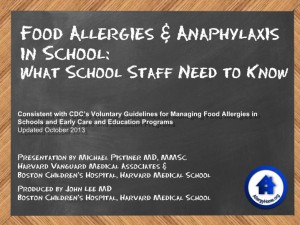 PREVIOUS MYTH:
All anaphylactic reactions have skin symptoms
PREVIOUS MYTH:
All anaphylactic reactions have skin symptoms
 NEXT MYTH:
Epinephrine auto-injectors can't be upsized to the 0.3mg dose until 66 lbs
NEXT MYTH:
Epinephrine auto-injectors can't be upsized to the 0.3mg dose until 66 lbs PREVIOUS MYTH:
All anaphylactic reactions have skin symptoms
PREVIOUS MYTH:
All anaphylactic reactions have skin symptoms
 NEXT MYTH:
Epinephrine auto-injectors can't be upsized to the 0.3mg dose until 66 lbs
NEXT MYTH:
Epinephrine auto-injectors can't be upsized to the 0.3mg dose until 66 lbs
 Staff Training: Food Allergies & Anaphylaxis in School – What School Staff Need to Know
Staff Training: Food Allergies & Anaphylaxis in School – What School Staff Need to Know
This 30 minute module is designed to assist the school nurse in staff training of management of life-threatening allergic reactions and increase food allergy awareness for all school staff including teachers, food service personnel, administrators, aides, specialists, coaches, bus drivers, custodians and others.
“Give antihistamine first when treating anaphylaxis.”
Epinephrine is the first line treatment for anaphylaxis. Antihistamines are slow to act and haven’t been shown to prevent or stop anaphylaxis.
Epinephrine is the treatment of choice for anaphylaxis. Delays in the administration of epinephrine are associated with an increased risk of death. Antihistamines do not treat life threatening symptoms; therefore if used then antihistamines CANNOT be allowed to delay the use of epinephrine (NIAID Guidelines for the Diagnosis and Management of Food Allergy in the United States). All staff should be familiar with and have access to the emergency care plans of any student that they are responsible for. All staff should be trained to recognize allergic reactions and know their role in the school emergency protocol.
Get Trained: NASN tool and resource for training unlicensed school staff to administer an epinephrine auto injector during an allergic emergency.
Anaphylaxis: What School Staff Need to Know : Written supplemental material that supports the AllergyHome training module. This is designed to reinforce key principles in the management and recognition of anaphylaxis by school staff.
All information contained on the Schools.AllergyHome.org website is intended for informational and educational purposes. The information provided on this website is not intended to be a replacement or substitute for professional medical advice. Any information that you have received from Schools.AllergyHome.org should be verified with your licensed health care provider. Furthermore, decisions regarding medical care should not be based solely upon the content of this website but made after discussions with your health care provider. Consumers should never disregard or delay seeking medical advice due to the content of this site.
Your use of this site does not create a patient-physician relationship between you and AllergyHome.org.
Medical information changes constantly. Therefore the information on this site or on the linked websites should not be considered current, complete or exhaustive, nor should you rely on such information to recommend a course of treatment for you or any other individual. Reliance on any information provided on this site or any linked websites is solely at your own risk.
Please note that AllergyHome is not affiliated with Boston Children’s Hospital